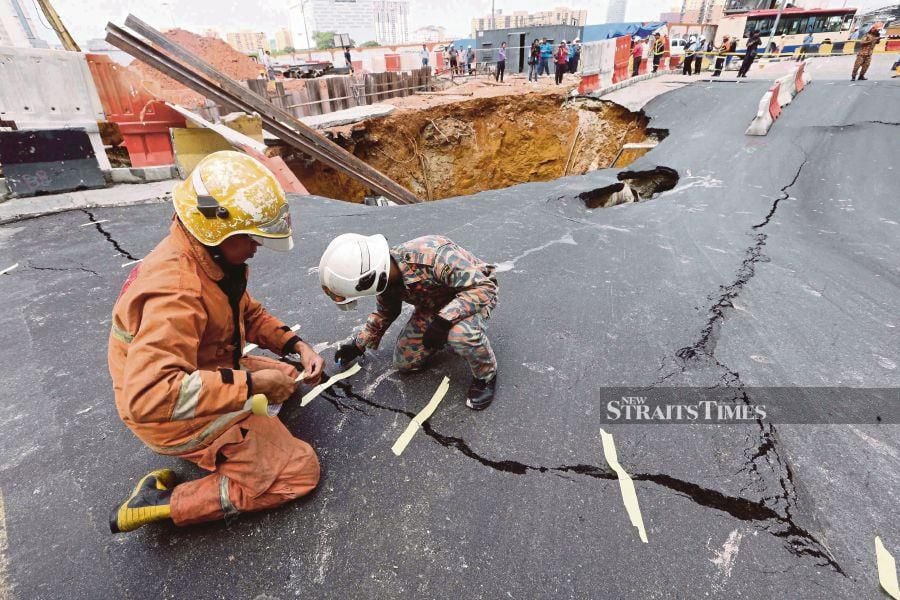KUALA LUMPUR: Despite what has been dubbed as a scary geological foreshadowing, the three sinkholes that appeared in the capital here within three days this week do not mean the city is caving in.
Selangor and Federal Territories Minerals and Geoscience Department director Jontih Enggihon, who dismissed suggestions that the city’s foundation could be collapsing, said large sinkholes usually occurred in places with limestone formations.
“However, the three areas are not resting on limestone formations. They are instead part of the Kenny Hill formation, which occurs over a large part of the city,” he told the New Straits Times.
“This is quartzite and phyllite — very strong, hard rocks that have weathered over hundreds of million years.
“So there is no cave or cavity developing beneath us, or a giant sinkhole threatening to pull the ground from our feet.”
He also dismissed suggestions of geological dangers despite the sinkholes having appeared within three days, from Sunday to Tuesday.
They were located between 700m and 2km from one another.
Following the formation of the sinkholes, panic-stricken city folk have drawn parallels to larger sinkholes in other parts of the world, such as the 19m-wide and 30m-deep sinkhole in Guatemala City, Mexico, which swallowed a three-storey building and killed 15 people in 2010.
Jontih said based on report by his team of geologists, flowing water from heavy rainfall was likely the reason why the sinkholes appeared.
He said further investigation could not be conducted as the sites had been closed when they arrived for checks on Thursday.
“Our theory is that the hole was created by fast-flowing water pressure on the old piping.
“However, I cannot speculate where the water came from because when we arrived on Thursday morning, everything had been covered and repaired.”
“At Dewan Bahasa dan Pustaka, my officers found a drain with the concrete wall embanking it broken, so you can imagine the level of rainfall.
“When the water flows fast, it goes everywhere and forces itself into whatever gap it can find along the way.”
Jontih said records of a previous soil analysis found that the formation at Jalan Maharajalala near the 3m-wide sinkhole had been somewhat altered.
He, however, said the data were limited and outdated, hence more analysis was needed.
On whether it was time to scale down development, traffic load and constructions, Jontih declined to comment.
He said there was no evidence that the development in the area had contributed to the phenomena.
“There is no construction near Jalan Pinang and Dewan Bahasa dan Pustaka.
“In Jalan Maharajalela, there are two sites, but they are 40m and 90m away from the sinkhole.”
On Wednesday, Pengurusan Air Selangor Sdn Bhd Corporate Communications Department head Halem Mat Som stated that it had conducted a detailed investigation to establish the cause of the burst pipes.
Although the actual findings were not made available, he said there were various factors as to why it could have happened, including possible soil movement due to vibrations or a strong physical force.
He said this was usually the case when pipes were located not far from a construction site or below the road surface.
Jontih said he had yet to be shown the report from Air Selangor, but he had been called by Kuala Lumpur City Hall for a meeting and expected to get a clearer picture soon.
After the NST front-paged concerns by experts over the sinkhole, City Hall stated that it planned to put in place an interagency mapping system covering the city’s underground utility lines.
Mayor Datuk Nor Hisham Ahmad Dahlan had, in a news report published on Thursday, said the city did not have a proper underground mapping system and this made it difficult to determine when the pipes could burst and cause such an incident.
He said the study would look into why the recent sinkholes appeared, and it would involve the Minerals and Geoscience Department and utility companies.
Another report, quoting Federal Territories Minister Khalid Samad, singled out utility providers as responsible for the sinkholes and their failure in providing proper coordinates of the pipes.
Local government expert Derek Fernandez raised concerns over the formation of the three sinkholes.
He said City Hall needed to investigate why the pipes burst by working with the authorities, including the Minerals and Geoscience Department and Air Selangor.
“It’s their job to do so as planners and regulators. The report must also be made public,” he said, adding that the police and Road Transport Department should be involved in the investigation.
On whether the driver whose car was partially swallowed should seek compensation, Fernandez said it could be done if there was a detailed report on the matter.
“The driver could seek redress and compensation for damages and physical injury, trauma or legal expenses.
“The driver could also find out if the accident could have been avoided and whether other parties could be held responsible for it,” he said.
The three sinkholes that appeared in the city were allegedly due to burst underground pipes.
Two were within 700m of each other in Jalan Maharajalela and the main gate of Dewan Bahasa dan Pustaka on Sunday night and Tuesday morning, respectively.
The sinkhole that appeared in Jalan Maharajalela was 3m wide and swallowed a car heading towards Jalan Loke Yew.
The other sinkhole appeared in Jalan Pinang on Tuesday morning.






